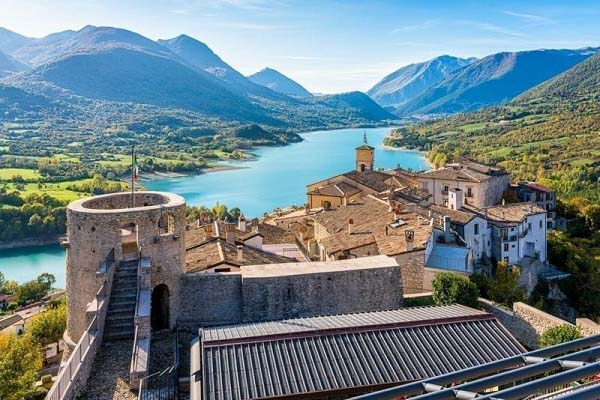Italy: This region may be the best-kept secret

Jessica Colley Clarke
I grew up hearing the word—Abruzzo—but didn’t know what it meant. The older generation, their parents born in Italy, often spoke words I didn’t understand. Words of emphasis, food words, sometimes whispered words. As I got older, it became clear that Abruzzo was a place, and not just any place but the most beautiful place in all of Italy, spoken of fondly with watery eyes, by immigrants who wondered if they’d ever set foot again where they were born.
The first time I looked it up, I found it on a map. Italy has 20 regions; some like Tuscany and Sicily are well known. Others like Abruzzo, tucked between the sea to the east and Lazio (home to the city of Rome) to the west, remain unfamiliar to most travelers. In a country of UNESCO-listed monuments and iconic cities, Abruzzo has neither. Yet it is the very absence of traditional tourist infrastructure that is why Abruzzo holds such allure for me—and what makes it ideal as the latest selection in our series on underrated destinations, It’s Still a Big World.
I longed to travel to Abruzzo for as far back as I can remember. When my mother retired, there was only one place we both wanted to go to mark the milestone. We found a cooking school, Abruzzo Cibus, located in a medieval hilltop hamlet called Carunchio, population 600. A vision quickly formed: a week at a hilltop palazzo in our family’s native region, cracking eggs into flour for fresh pasta dough, tasting our way through a local cheese shop, and learning the traditional recipes of our ancestors. As soon as we imagined this mother/daughter cooking getaway, it became irresistible; we booked immediately.
In May, we flew to Rome, giggling in excitement like two schoolgirls as the plane took off. A driver from the cooking school met us at the airport and we set out on the three-hour journey to Abruzzo. Carunchio first comes into view at a distance, perched on a hilltop. It’s a village of stone walls, red terra cotta roofs, and a charming church with a tall belltower at the highest point on the hill. As the van started to climb switchback turns, the village’s wildflowers, crooked lanes, stone steps, and ancient wooden doors all came into view. Carunchio is far from the Italy of T-shirts and trinkets; it’s church bells and laundry suspended on lines and a simple wooden table under the shade of a trellis.
“Abruzzo doesn’t have a name brand, or a major landmark, there are no big cities,” said Massimo Criscio, host and proprietor of Abruzzo Cibus, who met us on arrival at his 12-room palazzo. “Abruzzo is already hidden in Italy, and Carunchio is hidden within the hidden place. For certain travelers, that can be very appealing.” On stepping out of the van around twilight, we were greeted by a sweeping view back down over the grassy hillsides of the valley. “In Carunchio, local people are not even expecting tourists. They are surprised to see tourists,” Massimo told me. “This is a very different experience than other parts of Italy.”
Within an hour of arrival, we were settled into our cozy room at Palazzo Tour d’Eau, a grand home which dates back to 1730, and walked out onto the terrace for a pre-dinner drink. Were we just jet-lagged, or was the spritz, sipped as we lazed in a swing watching the sunset, the very best spritz I’d ever tasted? After a welcome dinner of pasta, free-flowing Montepulciano d’Abruzzo, and chatting with our fellow cooking school attendees, we sunk into a heavy sleep that not even morning church bells could disturb.

The following day, before breakfast and a cooking class, I wanted to get my bearings in the village, so my mom and I laced up our sneakers. We walked along steep stone steps and lanes so narrow we could smell the morning coffee on the stove, practically peer into the windows of the local villagers, and listen to their emphatic conversations. At the central bar/café, we were the only customers, and the barman took his time steaming milk for our morning cappuccino. We sat outside at a tiny table watching locals walk by, savoring the cool morning breeze and the quiet and a rumble in the stomach knowing a day of good eating lay ahead.
Back at the palazzo, it was time to cook. Walking into the cooking school kitchen, we were greeted by a wood-burning oven with fragrant, smoldering logs and tables set with knives and dish towels alongside bright eggplant, peppers, tomatoes, herbs, and garlic. Italy is, of course, a country of regional cuisines, and Abruzzese fare has its own style and flavors. With a history of poverty, this region is known for its peasant dishes. “Our cuisine has no fuss, is all about flavor,” said Massimo Criscio. “We use a very small amount of ingredients, but each ingredient must be top notch. If we use a tomato, it must be the best tomato.”
Over the course of the week, we cooked a menu of elevated peasant fare, including several vegetarian dishes such as pallotte cacio e uova, or bread and cheese dumplings in a sauce of peppers, tomato, and onion. We tasted a local hot spice blend called pepe tritto, tossed over spaghetti, that was both wonderfully simple and yet surprising. (“It must be simple, it must be flavorful,” Massimo said.) We hand-rolled cavatelli and found new life for stale bread and remarked on the density of flavor in a red pepper—how could it be that one pepper could contain so much life? I watched my mother with one of the biggest smiles on her face I’d ever seen; she even fell asleep at night with that smile on her face.
This seven-day cooking getaway offered plenty of time for hands in pasta dough and baking almond biscotti and learning about local DOC wines during a sommelier-led wine class, but the trip also included several excursions out into Abruzzo. We walked an olive grove, got up close to a traditional olive press, and tasted extra virgin oil at the source. We visited a cheesemaker, to witness the process of caciocavallo cheese being made from start to finish. We tasted our way through the regional flavors that our ancestors would have missed so deeply once they left Abruzzo for America.
The most striking excursion was to the Adriatic Coast and the town of Vasto, where my maternal family comes from. This stretch of coastline is home to the region’s traditional trabocchi, or fishing houses. These spindly wooden structures on stilts, once used for fishing, are now repurposed into unfussy restaurants. Stepping on the dock to walk out to the fishing platform on a sunny afternoon, we were surrounded by the various colors of the Adriatic, the slap of the sea breeze, and the melody of the local dialect.
At these fishing houses, an open-air deck is the setting for a seafood lunch. Where our ancestors once fished for sardines and sea bass, we feasted on crudo with olive oil and lemon; tiny fish battered and fried into one crunchy bite; and briny seafood pasta. There are too few truly perfect afternoons in life, but this was one of them, and in addition to the pleasures of the food and the cold white wine and the company, those hours also offered a sense of education and connection to our roots.
Visitors interested in exploring the trabocchi coastline further can do so by bicycle; a new bike trail recently opened that follows a former train track along the coast. The trail extends from Vasto north toward Pescara, a stretch of 42 kilometers with views of the sea, beaches, and the trabocchi. Back at the palazzo, guests of Abruzzo Cibus can recover from a long bike ride at the new on-site spa, home to three outdoor hot tubs, a steam room, and an all-glass hilltop sauna with panoramic views (massages and spa treatments including facials are available).
On our final night in Carunchio, we donned aprons one last time to roll out pizza dough for the wood-burning oven. I’d spent more quality time with my mom—talking about hopes, happy memories, and hardships—than I had in the entire year prior. Around a table we gathered for pizza scorching hot from the oven, wine glasses always full, music from an accordion, and laughter. There’s a reason people dream about Italy, why it’s always at the top of travelers’ wishlists. The pleasures are simple, and perhaps even more so if you opt to explore regions travelers sometimes overlook. I went to sleep that night grateful our ancestors guided us there.





